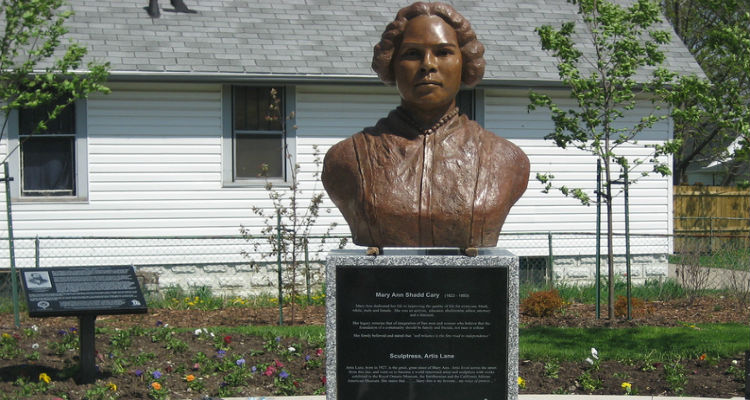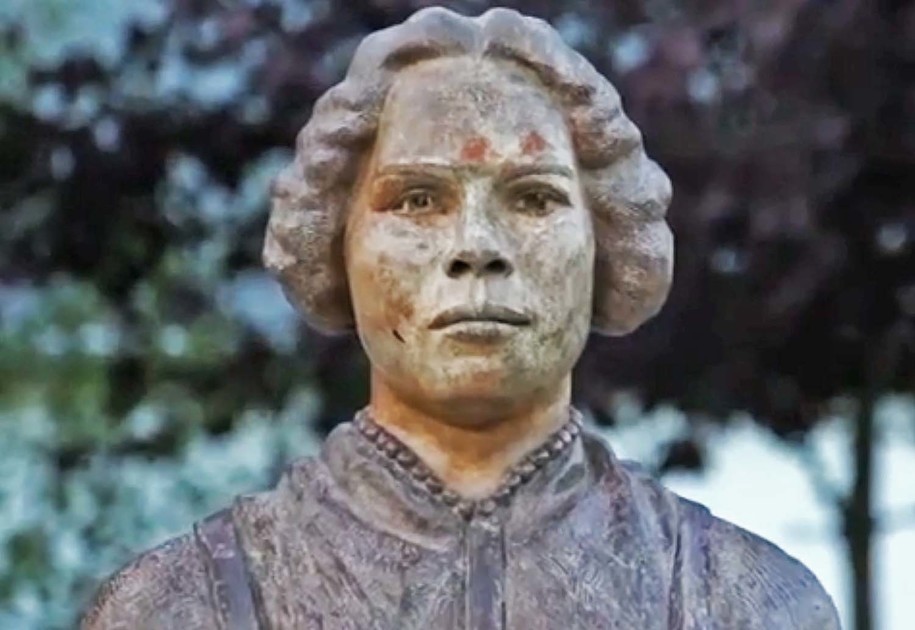Mary Ann Shadd Cary – Educator, Publisher, and Abolitionist
Mary Ann Camberton Shadd Cary, educator, publisher, abolitionist (born 9 October 1823 in Wilmington, Delaware; died 5 June 1893 in Washington, DC). The first Black female newspaper publisher in Canada, Shadd founded and edited The Provincial Freeman. She also established a racially integrated school for Black refugees in Windsor, Canada West. In 1994, Shadd was designated a Person of National Historic Significance in Canada.
Born to free parents in Delaware, a slave state, Mary Ann Shadd was the eldest of 13 children. She was educated by Quakers and later taught throughout the northeastern United States, including New York City. Following in the footsteps of her activist parents, whose home was a safe house (or “station”) on the Underground Railroad, Shadd pursued community activism upon settling in Canada.
On 10 September 1851, at St. Lawrence Hall, Shadd attended the first North American Convention of Coloured Freemen held outside of the United States. The event was presided over by Henry Bibb, Josiah Henson, J.T. Fisher, as well as other prominent figures, and was attended by hundreds of Black community leaders from all over Canada, the northern United States, and England. Many Convention delegates encouraged enslaved Americans and refugees from enslavement to enter Canada. The year before, the United States had passed the Fugitive Slave Act, which allowed slave owners to recapture escaped enslaved persons in states where enslavement had been abolished.
At the Convention, Henry and Mary Bibb, activists and publishers of the newspaper Voice of the Fugitive, met and convinced Shadd to take a teaching position near their home in Sandwich (now Windsor), Canada West. After settling there in 1851, Shadd set up a racially integrated school that was open to all who could afford to attend (education was not publicly provided at that time). The school was opened with financial support from the American Missionary Association.
Shadd wrote educational booklets that outlined the advantages of Canada for settlers moving north, including A Plea for Emigration; or Notes of Canada West (1852). About this time, Shadd, who opposed segregated schools for Black children, engaged in a heated debate with Henry and Mary Bibb, who favored segregation. The dispute informed many editorials written by the Bibbs and Shadd in Voice of the Fugitive. As a result of the public dispute, Shadd lost funding from the American Missionary Association for her school.
An estimated 30,000 to 40,000 freedom-seekers — born free or enslaved — reached Canada through the Underground Railroad. In 1850, over 35,000 Black persons lived in Canada West. To promote emigration to Canada, Shadd publicized the successes of Black persons living in freedom in Canada through The Provincial Freeman, a weekly newspaper first printed on 24 March 1853. This made Shadd the first Black woman in North America to publish a newspaper, and one of the first female journalists in Canada. “Self-Reliance Is the True Road to Independence” was the paper’s motto.
Co-edited by Samuel Ringgold Ward, a well-known public speaker and escaped enslaved person living in Toronto, the paper was published from Windsor (1853–1854), Toronto (1854–1855) and Chatham (1855–1857). While Ward was listed as editor on the paper’s masthead, Shadd did not list her own name or take any credit for articles written by her, thus concealing the paper’s female editorship. By 1860, the paper had succumbed to financial pressure and folded.
After spending the first few years of the American Civil War as a schoolteacher in Chatham, Shadd returned to the United States and began work as a recruitment agent for the Union Army. Later, she moved to Washington, DC, where she worked as a teacher. Years after, Shadd pursued law studies at Howard University and in 1883 became one of the first Black women to complete a law degree.

Note About This Image:
In response to the growing tensions surrounding slavery, Canadian members of the African Methodist Episcopal Church Conference formally established Chatham’s BME (Black Methodist Episcopal) Church in 1856. On this site, American Abolitionist John Brown held his initial meeting to gain supporters for his attack on Harpers Ferry, Virginia. Also, the fight to end segregation in Chatham schools was led by a minister from this church. In 1983, the church was designated a heritage building by the City of Chatham due to its significance as one of the earliest religious institutions owned and governed by former slaves who escaped to and settled in Canada. In 1989, the BME Church was demolished due to disrepair. The lot was vacant until the establishment of the BME Park in 2009. Chatham – Canada West/Ontario – is located 83 km (52 miles) east of Windsor.
Today’s Sources:
* CBC News Canada http://www.cbc.ca/news2/interactives/black-history-month/
* The Canadian Encyclopedia http://www.thecanadianencyclopedia.ca/en/article/mary-ann-shadd/?gclid=Cj0KCQiA2Y_UBRCGARIsALglqQ1EfTVAs6lx_QKPGjSlXdiTNiHiz-CG8-omYfzjM1I-jo9O-sa3KDwaAq17EALw_wcB


Wonderful post about a courageous leader. And you’ve told the story so well.
LikeLiked by 1 person
Yes, she was a very special kind of hero. Thanks, Robert.
LikeLiked by 1 person
Indeed. I also enjoyed reading about Canadian history.
LikeLiked by 1 person
I’m happy about that. I’m enjoying learning about Black History here in Canada.
LikeLiked by 1 person
Christy also has a fascinating post on the Canadian Suffrage Movement. She’s got quite a blog. 🙂
LikeLiked by 1 person
Yes, Christy’s work is special.
LikeLiked by 1 person
Yes. It’s a smart blog.
LikeLike
Sincerely wish I could repost your blog. It’s important!
LikeLike
Of course, you may repost this blog! Thank you for your interest!
LikeLike
Always!
LikeLike
Dear John Fioravanti,
This Mary Ann Shadd Cary is my kind of leader. She didn’t need the credit as she just wanted to get the job done. I love her motto about ““Self-Reliance Is the True Road to Independence.” I happen to really be a strong proponent of this philosophy.
I happen to agree with her about operating schools that weren’t segregated. She was a woman before her time.
Thanks for sharing her story.
Hugs, Gronda
LikeLiked by 1 person
I figured you’d identify with this lady! You are a strong, no-nonsense, tell it like it is kind of writer. Thanks for your lovely comment, Gronda!
LikeLiked by 1 person
Thanks for sharing!
LikeLike
Thanks for the share, Christy!
LikeLike
Wonderful! I enjoyed reading about her accomplishments (proud Canadian gal here!). I’ll include this one in the next roundup ❤
LikeLiked by 1 person
Thanks and thanks, Christy. I am so impressed by the courage and determination of these heroes I’m writing about for Black History Month. I’m learning a ton as I go along here!
LikeLiked by 1 person
Thanks for the share, Jill!
LikeLike
Great choice to highlight, John! But, as I was planning to re-blog, I cannot find a re-blog button. Same is the case with every blog I’ve visited … re-blog button all gone! I wonder if this is a temporary issue, of if WP has made another change and we can no longer re-blog? Sigh. If I have to, I will use PressThis later, but I much prefer re-blogging.
LikeLiked by 1 person
I discovered the same thing this morning – had to use the “Press This” button – and I don’t like it. Went into my settings and the option for showing the REBLOG button is still checked. Don’t know what happened. Thanks, Jill.
LikeLiked by 1 person
I did share this using “Press This”. There are three things I don’t like about ‘press this’. 1) the original author is not notified that his/her post has been shared; 2) it doesn’t show a snippet to grab the reader’s attention and pique their curiosity; 3) it takes longer. I worked around #2 when I shared yours by taking the liberty of copying the first paragraph of your post onto mine. But, I made the mistake of starting out with a small rant about the missing re-blog button, and all the comments I received were about the bloomin’ button instead of the content of the post! I find that we humans are so easily distracted by buttons! 😀 I do hope they haven’t permanently removed that button, or I will be grousing at them!
LikeLiked by 1 person
I found the same issues + you have to grab a picture or two from the original post to put it on your site. Pain in the butt!! What will happen is that there will be a lot fewer shared posts – or they will be stripped down to a link. Someone at WordPress needs their heads read. Thanks, Jill!
LikeLiked by 1 person
I popped into one of the WP forums tonight to see if I could find anything out about it, and one of the WP staff said that it is a glitch and that the techies are working on it. I hope that is the truth and that it will be back soon! You are right, there will be fewer shared posts, for it is tedious to have to use Press This, although my friend JB (Mr. Militant Negro) says he finds PressThis faster than ‘reblog’. I want my button back!
LikeLiked by 1 person
What an interesting history that school had, too, John. I’ll have to share this post with my son.
LikeLiked by 1 person
I’m stumbling across some awesome stories in this series, Cheryl. Thanks for sharing.
LikeLiked by 1 person
Thanks for the reblog, Opher.
LikeLike
What a story John.
LikeLiked by 1 person
She was a very courageous educator. Thanks, Opher!
LikeLike